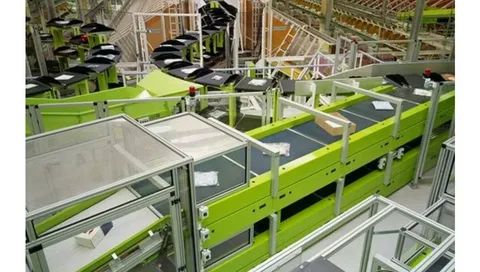Sortation systems play a crucial role in the world of logistics and e-commerce, enabling efficient and accurate package sorting in high-volume environments. These advanced automated solutions utilize state-of-the-art technologies to streamline the sorting process and ensure packages reach their intended destinations with precision.
From conveyors and sensors to barcode scanners and robotic arms, sortation systems employ a range of components to categorize items based on factors like destination, size, or weight. In this blog post, we will explore the different types of sortation systems, delve into their working principles, highlight their benefits, and discuss their applications across various industries.

What Is a Sortation System?
A sortation system is an automated solution designed to efficiently sort and distribute a wide range of items or packages based on predetermined criteria. It is commonly used in logistics and distribution centers to streamline the process of order fulfillment and improve overall operational efficiency.
By automating the sorting process, a sortation system helps reduce manual labor, minimize errors, and enhance the speed and accuracy of order processing. Here are the top seven features commonly found in sortation systems:
- High-Speed Sorting: Sortation systems are designed to handle a large number of items swiftly. They utilize advanced conveyor systems and automated mechanisms to sort items at high speeds, significantly improving operational efficiency and throughput.
- Diverse Sorting Capabilities: Sortation systems are versatile and can accommodate a wide range of item types. They can sort packages, parcels, cartons, totes, and other items of varying sizes, weights, and shapes. This flexibility allows businesses from different industries to utilize sortation systems for their specific needs.
- Multiple Sorting Destinations: Sortation systems enable items to be directed to multiple destinations based on predetermined criteria. For example, items can be sorted and sent to specific shipping lanes, packing areas, or routes, streamlining the subsequent stages of order fulfillment and enhancing overall logistics management.
- Precise Sorting Accuracy: Sortation systems utilize advanced technologies, such as barcode scanners, RFID (Radio Frequency Identification), or vision systems, to accurately identify and sort items based on their unique identifiers. This ensures that items are correctly sorted and reduces the likelihood of errors or misplacements.
- Merge and Divert Capabilities: Sortation systems often incorporate merge and divert modules, allowing items from multiple conveyor lines to merge onto a single line or divert to different routes. This feature helps optimize the flow of items and ensures efficient sorting based on predefined criteria.
- Automated Routing and Control: Sortation systems are typically equipped with automated routing and control software. This software manages the flow of items, determines their sorting destinations, and coordinates the movement of conveyors, diverters, and other sorting mechanisms. It provides real-time data and allows for efficient management and monitoring of the entire sorting process.
- Scalability and Modularity: Sortation systems are designed with scalability in mind. They can be easily expanded or modified to adapt to changing business requirements and accommodate increased throughput. Modularity allows for the addition or removal of sorting modules, providing flexibility to reconfigure the system as needed.
These features collectively make sortation systems an essential component of modern logistics and distribution operations, enabling businesses to improve order accuracy, reduce manual labor, enhance productivity, and meet customer demands efficiently.
Applications of a Sortation System
Sortation systems are widely used in various industries and applications to automate the process of sorting and distributing items. Here are some different applications of sortation systems:
- E-commerce and Retail: Sortation systems are extensively used in e-commerce and retail warehouses to handle the large volume of incoming orders. These systems can efficiently sort and route individual items or packages based on their destination, ensuring fast and accurate order fulfillment.
- Courier and Logistics: Sortation systems play a crucial role in courier and logistics facilities, where packages need to be sorted and routed to different destinations, such as specific cities, regions, or delivery routes. These systems enable faster and more efficient distribution of packages, reducing errors and improving overall delivery speed.
- Postal Services: Sorting machines are widely used in postal services to automate the sorting and processing of mail. They can read addresses and sort letters, envelopes, and parcels based on their postal codes or other predefined criteria. This automation helps postal services handle high volumes of mail more efficiently.
- Airport Baggage Handling: Sortation systems are an integral part of airport baggage handling systems. They enable automated routing and sorting of luggage based on flight destinations, ensuring that bags are loaded onto the correct aircraft. This technology improves baggage handling efficiency, reduces errors, and minimizes the chances of misrouted or lost luggage.
- Food and Beverage Distribution: Sortation systems are utilized in food and beverage distribution centers to sort and route products based on their specific requirements, such as temperature control or expiration dates. These systems ensure that perishable goods are handled appropriately and reach their destinations quickly, maintaining product quality and reducing waste.
- Manufacturing and Production: Sortation systems find applications in manufacturing and production facilities to sort and transport items between different stages of the production line. They can segregate products based on their attributes, such as size, weight, or type, facilitating efficient workflow management and improving overall productivity.
- Pharmaceutical and Healthcare: Sortation systems play a vital role in the pharmaceutical and healthcare industries, where precise sorting and tracking of medical supplies, medications, and equipment are crucial. These systems ensure the accurate and timely delivery of critical items to healthcare facilities, pharmacies, and patients.
- Parcel and Package Handling: Sortation systems are extensively used in parcel and package handling facilities, including distribution centers and courier hubs. They can automatically sort and route packages based on various criteria, such as destination ZIP codes, package dimensions, or customer preferences, enabling efficient package flow and minimizing delivery times.
- Library Systems: Sortation systems are used in libraries to automate the sorting and distribution of returned books. RFID (Radio Frequency Identification) technology is often integrated with sortation systems to identify and sort books based on their specific locations within the library. This helps library staff efficiently manage book returns and ensures that books are correctly shelved for easy retrieval.
- Waste Management: Sortation systems are increasingly employed in waste management facilities to automate the sorting and recycling of different types of waste materials. These systems can identify and sort recyclables, such as paper, plastics, glass, and metals, from general waste. By separating recyclable materials, sortation systems contribute to more effective waste management practices, promoting recycling and reducing landfill waste.
How to Choose a Sortation System for Your Business ?
Choosing the right sortation system for your business requires careful consideration of several factors. Here is a step-by-step guide to help you make an informed decision:
- Assess your needs: Begin by evaluating your business requirements and objectives. Consider factors such as order volume, product types, throughput rates, and order accuracy. This analysis will help you determine the specific capabilities you need in a sortation system.
- Analyze current operations: Review your existing order fulfillment processes and identify any bottlenecks or areas for improvement. Look for pain points that can be addressed by implementing a sortation system. This analysis will help you understand how a sortation system can enhance your operations.
- Understand sorting technologies: Familiarize yourself with the different types of sortation technologies available. Some common options include conveyor sortation, tilt-tray sortation, cross-belt sortation, and shoe sortation. Research and compare the features, benefits, and limitations of each technology to determine which one aligns best with your business requirements.
- Consider space and layout: Evaluate your facility’s space constraints and layout. Measure available floor space, ceiling height, and any other physical limitations that may impact the installation of a sortation system. This information will help you choose a system that can be accommodated within your facility.
- Evaluate scalability: Consider your business’s future growth projections and expansion plans. Look for a sortation system that can scale and adapt to increasing order volumes and changing operational needs. It should be flexible enough to accommodate future requirements without significant disruptions or costly modifications.
- Determine integration requirements: Assess the compatibility of the sortation system with your existing warehouse management system (WMS) or enterprise resource planning (ERP) software. Determine if any additional integration or customization is required to ensure seamless communication and data exchange between systems.
- Research vendors and solutions: Conduct thorough research on sortation system vendors and their solutions. Look for reputable vendors with a track record of successful implementations and reliable customer support. Compare the features, costs, and customer reviews of different systems to identify potential options that meet your needs.
- Request demos and references: Reach out to the shortlisted vendors and request product demos. Witness the system in action to assess its performance, ease of use, and compatibility with your operations. Additionally, ask for references from existing customers who have implemented the system to gain insights into their experiences.
- Evaluate the total cost of ownership (TCO): Consider the upfront costs, installation expenses, ongoing maintenance, and operational costs associated with the sortation system. Compare the TCO of different solutions to determine their long-term affordability and return on investment (ROI).
- Seek expert advice: If needed, consult with warehouse operations experts, system integrators, or consultants who specialize in sortation systems. They can provide valuable insights and help you make an informed decision based on their industry knowledge and experience.
- Make a decision: After carefully considering all the above factors, select the sortation system that best fits your business requirements, budget, and future growth plans. Communicate your decision to the chosen vendor and proceed with the implementation process.
Conclusion
In conclusion, we can say that sortation systems play a crucial role in optimizing warehouse operations by efficiently sorting and distributing goods. They enhance productivity, accuracy, and speed, ultimately improving customer satisfaction.
With their expertise in automation solutions, Qodenext can assist businesses in implementing and optimizing sortation systems tailored to their specific needs. Contact Qodenext today to discover how their advanced technologies can revolutionize your sorting processes and drive operational excellence.


